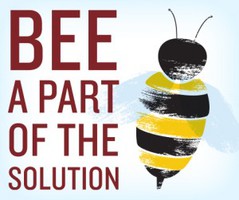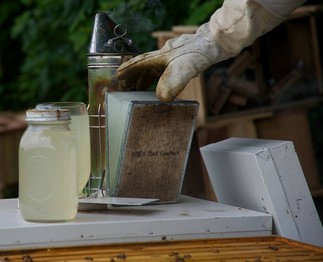If you see me running then things have gone poorly and you should run too...
-Amsey M.
Honey Bee Facts
Did You Know?
-
Honey bees evolved about 60 million years ago during the Cretaceous period.
-
There are no indigenous honey bees in the United States, European honey bees (German Black Bees) were first introduced into this country (Virginia) about 1621-22.
- 30% of our agrarian and up to 70% of our feral honey bee colonies have disappeared or died.
- Honey bees pollinate 30% of all the food that Americans consume and:
- Pollinate 85% of all flowering plants
- Perform 90% of all pollen transfers on our orchard crops
- One honey bee visits 50-100 flowers during each collection trip and can harvest several thousand flowers in a day, making 12 or more trips, gathering pollen or nectar from a single floral species each.
- Nectar collected from flowers is swallowed and in the honey stomach enzymes (invertase) are induced which convert the sugars (sucrose) into levulose and dextrose sugars.
- It takes about 556 worker bees to gather 1 pound of honey from about 2 million flowers.
- It takes about 55,000 flight miles per gallon (12#) of honey.
- The average honey bee will make only 1/12 of a teaspoon of honey in its lifetime (6 weeks). These foragers are the oldest bees in the hive and it is during the last two weeks of their lives that they gather nectar, pollen, water, and propolis.
- A hive can gather pollen and nectar from up to 500 million flowers in a year.
- 9 pounds of honey is synthesized to make 1 pound of beeswax.
- The bees use about 8 gallons of water to make 1 gallon of honey.
During peak nectar flows, a healthy hive can produce 2 to 5 pounds of honey per day. A scaled colony in Maryland was reported to gain 25 pounds of brood, honeycomb and honey in one day.
- Honey bees can fly up to 6 miles from the hive at 15 mph with their wings beating 11,400 times per minute.
- Honey bees use the sun as a directional marker when leaving and returning to the hive. The returning foragers do a waggle dance on the vertical comb surfaces in a circle or figure eight pattern which shows the other bees in which direction, and how far to fly.
-
Karl von Frisch won a Nobel Peace Prize in 1973 for his work on Honey Bee Communications.
- Roughly fifty thousand worker bees live in a colony along with one queen and several hundred drones.
- During the warmer months the worker bees live about six weeks, the queen can live up to three years.
- Worker bees born in the fall will live throughout the winter with the hive population being about half of what it is in the summer.
-
Average interior temperature of the hive's brood area is 93-95 degrees (F) regardless of the outside temperature. In colder weather they do not hibernate, but cluster generating heat much like musk-ox and penguins.
- There are approximately 2.7 million managed Honey Bee Hives in the USA.
-
Roughly between 1.8 and 2 million of those hives are moved into the Central Valley of California each February to pollinate almonds.
-
85% of the world’s almonds are grown in California. Almonds can not be grown commercially without honey bees to pollinate them.
-
The honey bee related pollination market is roughly a 15 billion dollar industry.
-
Catch The Buzz- Honey History
Sweeter Than Honey
The Egyptians were the first nomadic beekeepers, as they used to transport their hives by boat on the Nile, in search of different types of flowering plant.
Translated By Roger Marshall
And I have promised to bring you up out of your misery in Egypt into the land of the Canaanites, Hittites, Amorites, Perizzites, Hivites and Jebusites—a land flowing with milk and honey.’ (Ex. 3:17)
Although honey is a sweet substance made by bees and is therefore not an animal but an animal-based product, we shall nevertheless focus on them in this article due to their prominence in the Bible. In Hebrew there are several different words for honey.
One of them is debash, which, along with váar refers to the honey made by bees (1 Sam. 14:25, 27, 29; Song of Songs 5:1); another is tsuph, which literally means “to flow”, and denotes the hexagonal cells in the honeycombs, which are usually full of honey (Pr. 16:24; Psalm. 19:10); the next term used is nópheth, which is used to refer to the honey that drips from the honeycomb (Psalm 19:10); (Pr. 5:3; 24:13; 27:7; Song of Songs 4:11). All these Hebrew terms were translated into Greek as meli. Which means “honey” as a foodstuff.
Honey was always considered an excellent delicacy, especially on account of its delightful sweetness (Gn. 43:11; 2 S. 17:29). The Hebrews would obtain it from the honeycombs and ate it directly (1 Sam. 14:26). The manna that they ate during their wanderings in the Sinai desert had a taste which reminded them of honey (Ex. 16:31). Bees would often build their hives in the clefts of rocks, in trees and even in other quite bizarre places, such as the carcasses of certain animals (Dt. 32:13; Jud. 14:8; 1 S. 14:25; Mt. 3:4).
In the New Testament, the austere John the Baptist fed on wild honey (meli agrion) and insects such as locusts (Mt. 3:4). The chosen people of God also had to eat this honey, which flowed out of the rocks, while trekking through the desert (Dt. 32:13; Psalm 81:17). In the same way, the abundance of the Promised Land is indicated by the metaphor that “it flowed with milk and honey” (Ex. 3:8, 17; 13:5; 33:3). The excellence of the honey is also a metaphor to highlight the qualities of the beloved wife, when it is said of her, for example, that “Your lips drip nectar, my bride; honey and milk are under your tongue” (Song of Songs 4:11).
However, as honey is prone to ferment, being an organic product, it could not be burnt as an offering to God (Lv 2:11). Though this did not prevent it being offered to the priests for their own sustenance (2 Chronicles 31:2-5) And finally, in the New Testament we read that the disciples Jesus met on the road after his resurrection gave him “a piece of a broiled fish, and of a honeycomb” (Lc. 24:42).
Apart from the peoples of the Bible, honey was highly appreciated by many other cultures, such as the ancient Egyptians, the Greeks and the Romans. There are cave paintings from the Mesolithic period (8000 to 6000 BC), in which there are human figures collecting honey, in the Cueva de Araña in Bicorp (Valencia, Spain) for example [1]. It was considered by many to be a highly prized sacred product, and therefore used to pay taxes.
Ancient jars have been found containing honey, which was still perfectly edible, from the time of the Pharaohs. To the best of our knowledge, the Egyptians were the first nomadic beekeepers, as they used to transport their hives by boat on the Nile, in search of different types of flowering plant. In Israel, recent archaeological excavations in Tel Rehob, in the Beth-Sheán valley, have uncovered hives used in ancient times, dating from the times of the Israelite kings (10th to the 9th centuries BC). The hives, made from large cylindrical rods made of mud, are the only elements which occasionally make it possible to date archaeological excavations in the Ancient Middle East.
As bees often produce three times more honey than they need to live, human beings soon discovered that they could benefit from the excess, which was how beekeeping originated. This technique served to domesticate the insects, later providing them with artificial hives, and sedating them with smoke while they collected the excess honey. The different types and tastes of this highly esteemed product are due to the different types of flowers from which nectar is extracted, and to the types of bees that produced it. The pollination that the bees and other insects carry out is indispensable for the maintenance of the planet’s eco-systems.
Honey is a sweet viscous fluid whose color ranges from light yellow to dark brown, and is produced by bees belonging to the Apis species, from the nectar secreted by flowers or other types of vegetation. The intense sweetness of honey is due to the large amount of sugar it contains, such as glucose, fructose, maltose, isomaltose, sucrose, turanose and nigerose. It also possesses enzymes like amylase, catalase, acid phosphorylase, peroxide oxidase: it also contains amino acids, vitamins and minerals such as iron and zinc.
The inspired psalmist wrote the following words: “The law of the Lord is perfect, converting the soul: the testimony of the Lord is sure, making wise the simple. The statutes of the Lord are right, rejoicing the heart: the commandment of the Lord is pure, enlightening the eyes. The fear of the Lord is clean, enduring forever: the judgments of the Lord are true and righteous altogether. More to be desired are they than gold, yea, than much fine gold: sweeter also than honey and the honeycomb”. (Psalm 19: 7-10)
The time that is devoted to reading and meditating on Holy Scripture does not only serve to enrich a person spiritually, but it also makes for the sweetest, most delightful moments of life. As the prophet Jerremiah would say, if we “eat” the Word of God, it will give us joy, because the Most High will speak directly to our hearts (Jeremiah 15:16).
Notes:
[1] Grimberg, Carl, 1983, Universal History, 1 «The dawn of civilization»,
Published in: Evangelical Focus – Zoe – Sweeter than honey
https://evangelicalfocus.com/zoe/8844/sweeter-than-honey
[2] Honey will not ferment if the moisture content is below 18.6% when extracted. There is no shelf life on honey and it will crystallize but last forever if stored correctly.-Apex Bee Company LLC 2022
_________________________________________________________































